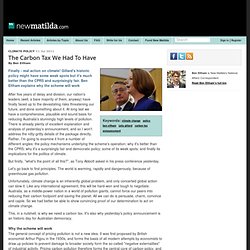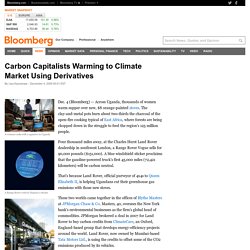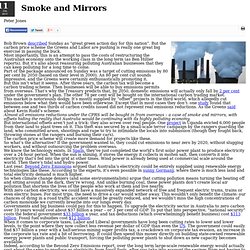

Carbon market primer pdf. The cost of carbon abatement. The Black Hole In Labor's Carbon Tax. How much carbon pollution will actually be reduced by the Gillard Government's carbon tax?

If you've been following the debate, you'll have the Prime Minister repeat the figure "160 million tonnnes" a number of times, which, she is keen to point out, is the equivalent of taking "45 million cars" off the road. The figure comes from the sophisticated economic modelling performed by Treasury for the carbon policy. The Treasury models suggests that to meet Australia's target of a 5 per cent cut in greenhouse gas emissions by 2020, we're going to have to emit around 152 million tonnes less pollution. But it turns out that the majority of this abatement does not come from Australian industry or consumers — or from Australia at all. According to Treasury, 94 million tonnes of that 152 million tonnes will come from "internationally-sourced abatement" (see the graph, obtained from Treasury, below).
To market, to market. Questions For Climate Change Minister Greg Combet. Beware The Climate Cowboy. Carbon credits market at point of collapse. Unpopular ... carbon credits.

Photo: Rob Homer. Government admits Britain will fail to meet 2010 carbon emission target - Times Online. Copenhagen's Hidden Agenda: The Multibillion Trade in Carbon Derivatives. As I have previously shown, speculative derivatives (especially credit default swaps) are a primary cause of the economic crisis.

And I have pointed out that (1) the giant banks will make a killing on carbon trading, (2) while the leading scientist crusading against global warming says it won’t work, and (3) there is a very high probability of massive fraud and insider trading in the carbon trading markets. Now, Bloomberg notes that the carbon trading scheme will be centered around derivatives: The banks are preparing to do with carbon what they’ve done before: design and market derivatives contracts that will help client companies hedge their price risk over the long term. They’re also ready to sell carbon-related financial products to outside investors. [Blythe] Masters says banks must be allowed to lead the way if a mandatory carbon-trading system is going to help save the planet at the lowest possible cost. Great Issues in Energy Symposium. Great Issues in Energy Symposium is an annual event featuring experts on a variety of energy-related topics. 2nd Annual Great Issues in Energy Symposium: The Nuclear Option April 9, 2010 Thayer School of Engineering at Dartmouth presented the second annual Great Issues in Energy Symposium on the topic of "The Nuclear Option.

" Featured speakers were: Dr. 1st Annual Great Issues in Energy Symposium: Climate April 2, 2009. Australia’s carbon price architecture explained « Climate Dilemma. 09_cap_and_trade_market_oversight_pirrong.pdf (application/pdf Object) California proposes delaying carbon market a year. Carb Market AUS NZ. Australia unveils details of carbon scheme. Offset providers growing impatient with California regulators. 1.1552101!ReutersEnergySummitJune2011.pdf (application/pdf Object) The Carbon Tax We Had To Have BenE. After five years of delay and division, our nation's leaders (well, a bare majority of them, anyway) have finally faced up to the devastating risks threatening our future, and done something about it.

At long last we have a comprehensive, plausible and sound basis for reducing Australia's stunningly high levels of pollution. There is already plenty of excellent explanation and analysis of yesterday's announcement, and so I won't address the nitty-gritty details of the package directly. Rather, I'm going to examine it from a number of different angles: the policy mechanisms underlying the scheme's operation; why it's better than the CPRS; why it's a surprisingly fair and democratic policy; some of its weak spots; and finally its implications for the politics of climate.
But firstly, "what's the point of all this? ", as Tony Abbott asked in his press conference yesterday. Let's go back to first principles. This, in a nutshell, is why we need a carbon tax. And an achievement is surely is. Smokescreen for inaction - Tad Liz. Find More Stories The carbon price debate as smokescreen for inaction Tad Tietze and Elizabeth Humphrys What if one of the biggest debates in federal politics today - the increasingly hysterical and partisan debate on a carbon price - actually mattered very little in terms of the practical outcomes purportedly being sought: the de-carbonisation of the Australian economy?
First some basic assumptions so that this doesn't get into a debate between "believers" and "sceptics". We are talking here to those, like us, who believe that climate change is real, human-driven, and poses a serious threat to ecology and society. World’s Largest Derivatives Market – Subprime Carbon.
Nathan Martin calls attention to the worlds largest derivatives market in the Carbon Cap and Trade system.

He links to a great CNBC video on “The Carbon Challenge”, in which former Governor and DNC Chairman Howard Dean declares “I am terrified of a Bernie Madoff in the Cap and Trade business who is selling stuff that doesn’t exist”. Let me be clear that I believe effective energy and carbon policy is the single most urgent and important matter for government to address. I fully agree with President Obama when he suggested on January 26 that ” no single issue is as fundamental to our future as energy. America’s dependence on oil is one of the most serious threats that our nation has faced. It bankrolls dictators, pays for nuclear proliferation and funds both sides of our struggle against terrorism. CDS and Carbon Derivatives: Two Sides of the Same Coin. SubprimeCarbonReport.pdf (application/pdf Object) Carbon Capitalists Warming to Climate Market Using Derivatives. A woman cooks with a ugastove in Uganda A Range Rover vehicle displays a sticker Range Rover vehicles sit on display Blythe Masters Dec. 4 (Bloomberg) -- Across Uganda, thousands of women warm supper over new, $8 orange-painted stoves.

Smoke and Mirrors. Bob Brown described Sunday as “great green action day for this nation”.

But the carbon price scheme the Greens and Labor are pushing is really one great big exercise in passing the buck. Most importantly, this is an attempt to pass the costs of restructuring the Australian economy onto the working class in the long term (as Ben Hillier reports). But it’s also about reassuring polluting Australian businesses that they can keep polluting for a long time to come. Part of the package announced on Sunday was a target of cutting emissions by 80 per cent by 2050 (based on their level in 2000). An 80 per cent cut sounds impressive, and the Greens were certainly enthusiastically promoting it. But this isn’t what it seems. This market is notoriously dodgy. Almost all emissions reductions under the CPRS will be bought in from overseas – a case of smoke and mirrors, with offsets hiding the reality that Australia would be continuing with its highly polluting economy.
Is Cap and Trade a Dead Policy Walking? In his February 24 speech to Congress, President Barack Obama asked Members “to send me legislation that places a market-based cap on carbon pollution.”

So yesterday, House Energy and Commerce Committee Chair Henry Waxman took the first step by introducing his cap-and-trade plan. Yet sometimes, the political sands shift underneath a policy approach that was once viable, even embraced broadly, and its chances of becoming law ebb away. Poison markets pdf.